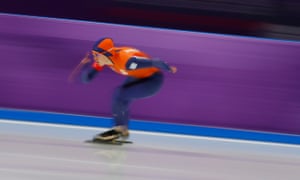Dutch fans take great pleasure in attempts to make sense of their dominance, particularly the frozen-canals theory

Ireen Wust became the most successful Dutch Olympian of all time as she won the women’s 1500m speed skating title at the Pyeongchang Games.
Photograph: Phil Noble/Reuters
Nicholas Tomalin reckoned that the three qualities a journalist needs to succeed are rat-like cunning, a plausible manner and a little literary ability, none of which are much use when you’re trying to tell a salchow from a toe-loop on a tight deadline. During the Winter Olympics it pays to be a quick study, too. Particularly in Britain, where the usual recreational activities in winter are football, baking potatoes and having a national freak-out about each smattering of snow. Because the first week of the Games always provokes perplexing questions, like why are the Dutch so damn good at speed skating?
As of Monday, the Netherlands had won 117 medals in the Winter Olympics. One was in snowboarding. One was in short track skating. Three were in figure skating. And 111 were in speed skating. In the first three days of this Games the Netherlands won six of the nine speed skating medals available. Which means they’re already halfway to their medal target of 12, and there are nine days of competition still to go. In Sochi in 2014 they won 23 of the sport’s 36 medals, which was reckoned to be the single most dominant performance by a country in any sport, at any Olympics.
The Dutch make the Jamaicans look like a nation of moderately successful sprinters, New Zealand seem a mildly competent rugby country. Their success has become one of the great mysteries of modern sport, along with the workings of the Duckworth-Lewis method, and Carlton Palmer’s 18 England caps. The International Skating Union was so put out by the Netherlands’ performance in 2014 that they even changed the competition rules to stop them entering so many skaters this time around.
The Dutch fans take great pleasure in everyone else’s attempts to make sense of their success. Katie Couric offered a particularly ripe explanation during NBC’s coverage of the opening ceremony. “Skating is an important mode of transportation in a city like Amsterdam which sits at sea level,” Couric explained. “As you all know, it has lots of canals that can freeze in the winters. So, for as long as those canals have existed, the Dutch have skated on them to get from place to place, to race each other, and also to have fun.”
All that ice skating must be hard work when you’re stoned. And wearing clogs. While holding a bouquet of tulips. And an Edam. On your way to work at the windmill. Listen closely to the NBC commentary and you can almost hear the pings as Couric’s Twitter feed lit up, followed by the dull thwack of her junior researcher being whacked around the back of the head with a rolled-up copy of her notes. Fortunately for Couric her gaffe was only the second worst NBC made. Her co-host copped even more flack online for implying that the Koreans were grateful to the Japanese for colonising them.
Couric wasn’t the first to repeat these strange ideas about how the Dutch get to work each day. A couple of journalists did it in 2014 and they were mercilessly lampooned too. The source text might as well be Mary Mapes Dodge’s children’s novel Hans Brinker, or The Silver Skates. Which was written back in 1865, and has been kept alive in two Disney movies and a couple of TV musicals too. Dodge had never actually been to the Netherlands when she wrote it but still felt able to describe it as a land where “whole families were skimming their way” along the grand canal, “belles from Leyden, and fishwives from the border villages; wrinkled old women with baskets upon their heads and plump little toddlers on skates clutching at their mothers’ gowns.”

People skate on the frozen Prinsengracht canal in Amsterdam in 2012, which was the last time the city’s canals froze over. Photograph: Margriet Faber/AP
Sadly, the canals in Amsterdam haven’t frozen over since 2012. And they haven’t been able to race the famous Elfstedentocht, the marathon skating race around Friesland, since 1997, because they haven’t had a winter cold enough since. It’s true that the Dutch do have a tradition of skating that, as the sports historian Marnix Koolhaas has written, it can be traced back to the Reformation, that the first skating world championships were held in Amsterdam in 1889, even that their first gold medallist, Carry Geijssen in 1968, said she sometimes skated to work along the frozen canals.
But the reasons for their success tend to be a little less Mapes Dodge than Couric made them sound. Until the mid-1990s the Dutch ran a centralised skating programme called the Kernploeg, which allowed six skaters to train full time. Then two of their star athletes broke away to set up their own commercial skating teams. And these days the Dutch system is entirely decentralised. They have eight professional skating teams who raise their own funds and run their own talent ID programmes, and support around 80 full-time athletes. Over half of those 111 medals have been won since this switch.
There are 20 long-track ice-rinks in the Netherlands, while there are only six of those in the entire US, and the Dutch national federation has 7,000 junior members. Which isn’t so very many, since the swimming federation has 75,000, but those 7,000 are all channelled into speed skating, whereas other countries split their talent between short track, ice hockey and figure skating. Still, there is hope for everyone else. Canada’s Ted-Jan Bloemen just finished second in the men’s 5,000m. Bloemen was born and raised in Gouda and became Canadian in 2014. If you can’t beat them, best recruit them instead.
